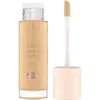What's inside
What's inside
 Key Ingredients
Key Ingredients

 Benefits
Benefits

 Concerns
Concerns

No concerns
 Ingredients Side-by-side
Ingredients Side-by-side

Water
Skin ConditioningCyclopentasiloxane
EmollientEthylhexyl Methoxycinnamate
UV AbsorberCyclohexasiloxane
EmollientDimethicone
EmollientRubus Chamaemorus Fruit Juice Extract
HumectantGlycerin
HumectantC13-15 Alkane
SolventBetula Alba Juice
AstringentIsododecane
EmollientDimethicone/Divinyldimethicone/Silsesquioxane Crosspolymer
HumectantMica
Cosmetic ColorantPolyglyceryl-4 Isostearate
EmulsifyingLauryl PEG-10 Tris(Trimethylsiloxy)Silylethyl Dimethicone
EmulsifyingMagnesium Sulfate
Cetyl PEG/PPG-10/1 Dimethicone
EmulsifyingHexyl Laurate
EmollientCetearyl Dimethicone Crosspolymer
Rubus Chamaemorus Seed Extract
Skin ConditioningPhenoxyethanol
PreservativeTitanium Dioxide
Cosmetic ColorantPropanediol
SolventTrimethylsiloxysilicate
EmollientTocopheryl Acetate
AntioxidantPolypropylsilsesquioxane
Aluminum Hydroxide
EmollientDisteardimonium Hectorite
StabilisingSilica
AbrasiveHydrolyzed Hyaluronic Acid
HumectantPentaerythrityl Tetra-Di-T-Butyl Hydroxyhydrocinnamate
AntioxidantEthylhexylglycerin
Skin ConditioningPropylene Carbonate
SolventHydrogen Dimethicone
Magnesium Stearate
Cosmetic ColorantTriethoxycaprylylsilane
Hydrated Silica
AbrasivePentylene Glycol
Skin ConditioningMagnesium Aspartate
Skin ConditioningZinc Gluconate
Skin ConditioningCopper Gluconate
Skin ConditioningCitric Acid
BufferingBenzyl Salicylate
PerfumingLinalool
PerfumingCitronellol
PerfumingParfum
MaskingIron Oxides
CI 77891
Cosmetic ColorantWater, Cyclopentasiloxane, Ethylhexyl Methoxycinnamate, Cyclohexasiloxane, Dimethicone, Rubus Chamaemorus Fruit Juice Extract, Glycerin, C13-15 Alkane, Betula Alba Juice, Isododecane, Dimethicone/Divinyldimethicone/Silsesquioxane Crosspolymer, Mica, Polyglyceryl-4 Isostearate, Lauryl PEG-10 Tris(Trimethylsiloxy)Silylethyl Dimethicone, Magnesium Sulfate, Cetyl PEG/PPG-10/1 Dimethicone, Hexyl Laurate, Cetearyl Dimethicone Crosspolymer, Rubus Chamaemorus Seed Extract, Phenoxyethanol, Titanium Dioxide, Propanediol, Trimethylsiloxysilicate, Tocopheryl Acetate, Polypropylsilsesquioxane, Aluminum Hydroxide, Disteardimonium Hectorite, Silica, Hydrolyzed Hyaluronic Acid, Pentaerythrityl Tetra-Di-T-Butyl Hydroxyhydrocinnamate, Ethylhexylglycerin, Propylene Carbonate, Hydrogen Dimethicone, Magnesium Stearate, Triethoxycaprylylsilane, Hydrated Silica, Pentylene Glycol, Magnesium Aspartate, Zinc Gluconate, Copper Gluconate, Citric Acid, Benzyl Salicylate, Linalool, Citronellol, Parfum, Iron Oxides, CI 77891
Water
Skin ConditioningHydrogenated Didecene
Skin ConditioningIsododecane
EmollientGlycerin
HumectantPropanediol
SolventSqualane
EmollientPolyglyceryl-4 Oleate
EmulsifyingHydrogenated Styrene/Isoprene Copolymer
Polyglyceryl-3 Polyricinoleate
EmulsifyingMagnesium Sulfate
Tocopherol
AntioxidantSynthetic Fluorphlogopite
Triethoxycaprylylsilane
Pentaerythrityl Tetra-Di-T-Butyl Hydroxyhydrocinnamate
AntioxidantPhenoxyethanol
PreservativeCI 77163
Cosmetic ColorantCI 77491
Cosmetic ColorantCI 77492
Cosmetic ColorantCI 77891
Cosmetic ColorantWater, Hydrogenated Didecene, Isododecane, Glycerin, Propanediol, Squalane, Polyglyceryl-4 Oleate, Hydrogenated Styrene/Isoprene Copolymer, Polyglyceryl-3 Polyricinoleate, Magnesium Sulfate, Tocopherol, Synthetic Fluorphlogopite, Triethoxycaprylylsilane, Pentaerythrityl Tetra-Di-T-Butyl Hydroxyhydrocinnamate, Phenoxyethanol, CI 77163, CI 77491, CI 77492, CI 77891
 Reviews
Reviews

Ingredients Explained
These ingredients are found in both products.
Ingredients higher up in an ingredient list are typically present in a larger amount.
Ci 77891 is a white pigment from Titanium dioxide. It is naturally found in minerals such as rutile and ilmenite.
It's main function is to add a white color to cosmetics. It can also be mixed with other colors to create different shades.
Ci 77891 is commonly found in sunscreens due to its ability to block UV rays.
Learn more about CI 77891Glycerin is already naturally found in your skin. It helps moisturize and protect your skin.
A study from 2016 found glycerin to be more effective as a humectant than AHAs and hyaluronic acid.
As a humectant, it helps the skin stay hydrated by pulling moisture to your skin. The low molecular weight of glycerin allows it to pull moisture into the deeper layers of your skin.
Hydrated skin improves your skin barrier; Your skin barrier helps protect against irritants and bacteria.
Glycerin has also been found to have antimicrobial and antiviral properties. Due to these properties, glycerin is often used in wound and burn treatments.
In cosmetics, glycerin is usually derived from plants such as soybean or palm. However, it can also be sourced from animals, such as tallow or animal fat.
This ingredient is organic, colorless, odorless, and non-toxic.
Glycerin is the name for this ingredient in American English. British English uses Glycerol/Glycerine.
Learn more about GlycerinIsododecane is a fragrance, emollient, and solvent.
As an emollient, it helps your skin stay soft and hydrated. Emollients help trap moisture into your skin.
Isododecane's role as a solvent makes it a great texture enhancer. It spreads smoothly on skin and does not leave a sticky feeling behind. Isododecane also helps prevent color transfer in makeup products.
Isododecane is not absorbed into skin.
Learn more about IsododecaneMagnesium Sulfate is a salt. More specifically, it is an epsom salt, or the bath salt used to help relieve muscle aches.
Despite having ‘sulfate’ in the name, it isn’t a surfactant or cleansing agent like sodium lauryl sulfate. Unlike those sulfates, magnesium sulfate doesn’t have the same cleansing or foaming properties (it's simply a type of salt).
In cosmetics, Magnesium Sulfate is used to thicken a product or help dilute other solids. It is a non-reactive and non-irritating ingredient.
One study shows magnesium deficiency may lead to inflammation of the skin. Applying magnesium topically may help reduce inflammation.
You can find this ingredient in sea water or mineral deposits.
Learn more about Magnesium SulfatePentaerythrityl Tetra-Di-T-Butyl Hydroxyhydrocinnamate (long name, huh?) is a synthetic antioxidant.
It is used to help stabilize other antioxidants or prevent the color from changing in a product.
As an antioxidant, it helps fight free-radical molecules. Free-radical molecules are capable of damaging our cells and other genetic material. Thus, antioxidants may reduce the signs of aging.
This ingredient is oil-soluble.
Learn more about Pentaerythrityl Tetra-Di-T-Butyl HydroxyhydrocinnamatePhenoxyethanol is a preservative that has germicide, antimicrobial, and aromatic properties. Studies show that phenoxyethanol can prevent microbial growth. By itself, it has a scent that is similar to that of a rose.
It's often used in formulations along with Caprylyl Glycol to preserve the shelf life of products.
Propanediol is an all-star ingredient. It softens, hydrates, and smooths the skin.
It’s often used to:
Propanediol is not likely to cause sensitivity and considered safe to use. It is derived from corn or petroleum with a clear color and no scent.
Learn more about PropanediolTriethoxycaprylylsilane is a silicone used to bind and stabilize ingredients.
As an emulsifier, it helps prevent ingredients from separating. This can help elongate the shelf life of products.
Triethoxycaprylylsilane is often used to coat mineral sunscreens ingredients to help give a better feel. It also helps reduce oxidative stress in sunscreens.
Learn more about TriethoxycaprylylsilaneWater. It's the most common cosmetic ingredient of all. You'll usually see it at the top of ingredient lists, meaning that it makes up the largest part of the product.
So why is it so popular? Water most often acts as a solvent - this means that it helps dissolve other ingredients into the formulation.
You'll also recognize water as that liquid we all need to stay alive. If you see this, drink a glass of water. Stay hydrated!
Learn more about Water